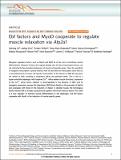Por favor, use este identificador para citar o enlazar a este item:
http://hdl.handle.net/10261/123543COMPARTIR / EXPORTAR:
 SHARE SHARE
 CORE
BASE CORE
BASE
|
|
| Visualizar otros formatos: MARC | Dublin Core | RDF | ORE | MODS | METS | DIDL | DATACITE | |

| Campo DC | Valor | Lengua/Idioma |
|---|---|---|
| dc.contributor.author | Jin, Saihong | - |
| dc.contributor.author | García-Domínguez, Mario | - |
| dc.contributor.author | Kieslinger, Matthias | - |
| dc.date.accessioned | 2015-10-20T06:44:13Z | - |
| dc.date.available | 2015-10-20T06:44:13Z | - |
| dc.date.issued | 2014-05-02 | - |
| dc.identifier | doi: 10.1038/ncomms4793 | - |
| dc.identifier | issn: 2041-1723 | - |
| dc.identifier.citation | Nature Communications 5: 3793 (2014) | - |
| dc.identifier.uri | http://hdl.handle.net/10261/123543 | - |
| dc.description | Jin, Saihong et al. | - |
| dc.description.abstract | Myogenic regulatory factors such as MyoD and Myf5 lie at the core of vertebrate muscle differentiation. However, E-boxes, the cognate binding sites for these transcription factors, are not restricted to the promoters/enhancers of muscle cell-specific genes. Thus, the specificity in myogenic transcription is poorly defined. Here we describe the transcription factor Ebf3 as a new determinant of muscle cell-specific transcription. In the absence of Ebf3 the lung does not unfold at birth, resulting in respiratory failure and perinatal death. This is due to a hypercontractile diaphragm with impaired Ca2+ efflux-related muscle functions. Expression of the Ca2+ pump Serca1 (Atp2a1) is downregulated in the absence of Ebf3, and its transgenic expression rescues this phenotype. Ebf3 binds directly to the promoter of Atp2a1 and synergises with MyoD in the induction of Atp2a1. In skeletal muscle, the homologous family member Ebf1 is strongly expressed and together with MyoD induces Atp2a1. Thus, Ebf3 is a new regulator of terminal muscle differentiation in the diaphragm, and Ebf factors cooperate with MyoD in the induction of muscle-specific genes. © 2014 Macmillan Publishers Limited. | - |
| dc.description.sponsorship | This work was supported by grants from the German Research Foundation (DFG, TRR54; FOR1586; FOR2033) and by a stipend of the Max Planck Society | - |
| dc.publisher | Nature Publishing Group | - |
| dc.relation.isversionof | Publisher's version | - |
| dc.rights | openAccess | - |
| dc.title | Ebf factors and MyoD cooperate to regulate muscle relaxation via Atp2a1 | - |
| dc.type | artículo | - |
| dc.identifier.doi | 10.1038/ncomms4793 | - |
| dc.relation.publisherversion | http://dx.doi.org/10.1038/ncomms4793 | - |
| dc.date.updated | 2015-10-20T06:44:13Z | - |
| dc.description.version | Peer Reviewed | - |
| dc.language.rfc3066 | eng | - |
| dc.rights.license | https://creativecommons.org/licenses/by-nc-nd/4.0/ | - |
| dc.contributor.funder | German Research Foundation | - |
| dc.contributor.funder | Max Planck Society | - |
| dc.relation.csic | Sí | - |
| dc.identifier.funder | http://dx.doi.org/10.13039/501100001659 | es_ES |
| dc.identifier.funder | http://dx.doi.org/10.13039/501100004189 | es_ES |
| dc.type.coar | http://purl.org/coar/resource_type/c_6501 | es_ES |
| item.fulltext | With Fulltext | - |
| item.openairecristype | http://purl.org/coar/resource_type/c_18cf | - |
| item.openairetype | artículo | - |
| item.cerifentitytype | Publications | - |
| item.grantfulltext | open | - |
| Aparece en las colecciones: | (CABIMER) Artículos | |
Ficheros en este ítem:
| Fichero | Descripción | Tamaño | Formato | |
|---|---|---|---|---|
| Ebf_factors_Jin.pdf | 2,22 MB | Adobe PDF |  Visualizar/Abrir |
CORE Recommender
SCOPUSTM
Citations
27
checked on 10-abr-2024
WEB OF SCIENCETM
Citations
27
checked on 18-feb-2024
Page view(s)
285
checked on 23-abr-2024
Download(s)
361
checked on 23-abr-2024
Google ScholarTM
Check
Altmetric
Altmetric
Este item está licenciado bajo una Licencia Creative Commons

